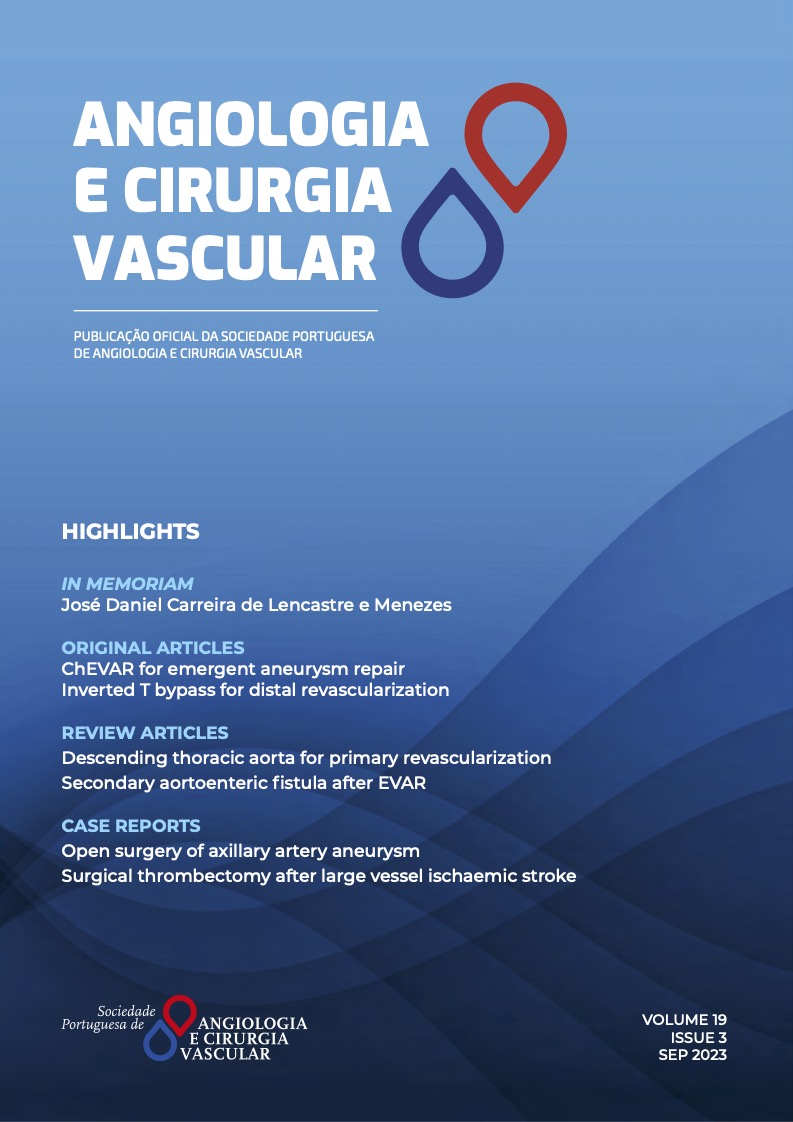Surgical thrombectomy after large vessel ischaemic stroke – a case report
DOI:
https://doi.org/10.48750/acv.541Keywords:
Surgical thrombectomy, Acute ischaemic stroke, thrombolysis in cerebral infarction, stent-retriever, common carotid arteryAbstract
BACKGROUND: Endovascular mechanical thrombectomy (MT) changed acute ischaemic stroke management and is considered the standard of care for patients with proximal anterior circulation occlusion. MT improves functional independence, without an increase in mortality. Despite its advantages, up to 20% of patients treated with MT do not have successful recanalization, leading to poor clinical outcome. We present a case of an acute ischaemic stroke of the anterior circulation due to occlusion of the common carotid artery successfully submitted to surgical thrombectomy after failed MT.CASE REPORT: A 43-year-old male, with prior history of diabetes, hypertension, dyslipidaemia and heart failure was admitted at the emergency unit with acute bilateral lower limb ischaemia, due to cardioembolic phenomena. He was submitted to bilateral femoral thrombectomy and started endovenous unfractionated heparin. On the fifth postoperative day he developed sudden depression of cognitive status and left side hemiplegia of brachial predominance. Computed tomography angiography revealed an occlusion of brachiocephalic trunk, right subclavian artery and common carotid artery, preserving its branches. MT, performed by interventional neuroradiology, was unsuccessful (no recanalization or clinical improvement). After multidisciplinary discussion, the patient underwent urgent surgical thrombectomy through carotid and transaxillary approaches. Postoperatively, the patient’s mental status and left sided motor function recovered progressively over time. Three months after, patient maintains anticoagulation with warfarin, without neurological sequalae.
CONCLUSION: The low rate of recanalization and poor clinical outcome after MT failure underlines the need for alternative rescue approaches. Surgical thrombectomy could represent a lifeline. More studies are needed to corroborate its efficacy in patients with anterior circulation acute ischaemic stroke.
Downloads
References
Goyal M, Menon BK, van Zwam WH, Dippel DW, Mitchell PJ, Demchuk AM, et al, HERMES collaborators. Endovascular thrombectomy after large-vessel ischaemic stroke: a meta-analysis of individual patient data from five randomised trials. Lancet. 2016;387:1723-31.
Yeo LLL, Bhogal P, Gopinathan A, Cunli Y, Tan B, Andersson T. Why Does Mechanical Thrombectomy in Large Vessel Occlusion Sometimes Fail?: A Review of the Literature. Clin Neuroradiol. 2019;29:401-14.
Bracard S, Ducrocq X, Mas JL, Soudant M, Oppenheim C, Moulin T, Guillemin F; THRACE investigators. Mechanical thrombectomy after intravenous alteplase versus alteplase alone after stroke (THRACE): a randomised controlled trial. Lancet Neurol. 2016;15:1138-47. Erratum in: Lancet Neurol. 2016;15:1203.
Saver JL, Goyal M, van der Lugt A, Menon BK, Majoie CB, Dippel DW, et al; HERMES Collaborators. Time to Treatment With Endovascular Thrombectomy and Outcomes From Ischemic Stroke: A Meta-analysis. JAMA. 2016;316:1279-88.
Heider DM, Simgen A, Wagenpfeil G, Dietrich P, Yilmaz U, Mühl-Benninghaus R, et al. Why we fail: mechanisms and co-factors of unsuccessful thrombectomy in acute ischemic stroke. Neurol Sci. 2020;41:1547-55.
Leischner H, Flottmann F, Hanning U, Broocks G, Faizy TD, Deb-Chatterji M, et al. Reasons for failed endovascular recanalization attempts in stroke patients. J Neurointerv Surg. 2019;11:439-42.
Kaesmacher J, Gralla J, Mosimann PJ, Zibold F, Heldner MR, Piechowiak E, et al. Reasons for Reperfusion Failures in Stent-Retriever-Based Thrombectomy: Registry Analysis and Proposal of a Classification System. AJNR Am J Neuroradiol. 2018;39:1848-53.
Moftakhar P, English JD, Cooke DL, Kim WT, Stout C, Smith WS, et al. Density of thrombus on admission CT predicts revascularization efficacy in large vessel occlusion acute ischemic stroke. Stroke. 2013;44:243-5.
Campbell BC, Mitchell PJ, Kleinig TJ, Dewey HM, Churilov L, Yassi N, et al; EXTEND-IA Investigators. Endovascular therapy for ischemic stroke with perfusion-imaging selection. N Engl J Med. 2015;372:1009-18.
Jovin TG, Chamorro A, Cobo E, de Miquel MA, Molina CA, Rovira A, et al; REVASCAT Trial Investigators. Thrombectomy within 8 hours after symptom onset in ischemic stroke. N Engl J Med. 2015;372:2296-306.
Berkhemer OA, Fransen PS, Beumer D, van den Berg LA, Lingsma HF, Yoo AJ, et al; MR CLEAN Investigators. A randomized trial of intraarterial treatment for acute ischemic stroke. N Engl J Med. 2015;372:11-20. Erratum in: N Engl J Med. 2015;372:394.
Gunning GM, McArdle K, Mirza M, Duffy S, Gilvarry M, Brouwer PA. Clot friction variation with fibrin content; implications for resistance to thrombectomy. J Neurointerv Surg. 2018;10:34-8.









